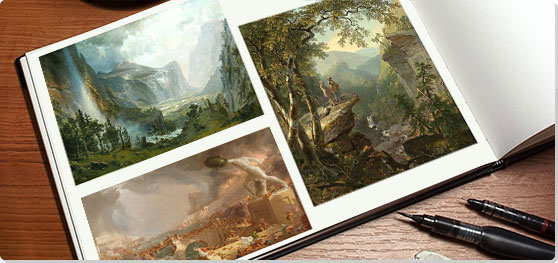Summary of The Hudson River School
Searching for a national style of art, the American landscape itself - large and untamed - was the primary focus of the Hudson River School painters. American expansion and Manifest Destiny imbued the untamed countryside with the symbolism of the country's promised prosperity and limitless resources. The terrain provided an alternative to European culture and history; it became a picturesque, patriotic, and inspirational theme. This loosely connected group of painters explored the nation, returning to their New York studios to paint large-scale works that thrilled audiences and celebrated the awesome power of nature and the progress of man.
Key Ideas & Accomplishments
- Long considered a profitable, but lowly, subject for serious artists (since it involved merely copying what was seen), landscape painting received new attention in the mid-19th century. Like Romantic painters in Britain and Germany, Hudson River School artists embraced the landscape as a meaningful subject, precisely as industrialization began to change terrains and reshape man's connection to his environment. The Americans both championed these forces of modernization and lamented what was lost in the name of "progress."
- Generations of American painters had returned to Europe for training and adopted the styles and subjects of Old World artists. The Hudson River School painters desired a more native tradition, painting recognizably American scenes. Personally and professionally, they formed networks with writers and philosophers to create a distinct American culture.
- Artists like Thomas Cole invested the landscape with symbolism, suggesting that these natural scenes could be transformed into meaningful allegories, as well as immersive and transformative experiences for the viewer. With their careful attention to realism and precise illusionism, as well as complex messaging and awe-inspiring vistas, the resulting canvases could be appreciated on both intellectual and emotional levels.
- The second generation of Hudson River School painters left the New York area to explore more far-flung regions of America. Their painting documented westward expansion and reinforced the concept of Manifest Destiny. During the Civil War, their majestic images of an unspoiled West provided hope for post-war reconciliation and the promise of expanses of wild country, full of promise and unscarred by battle.
Artworks and Artists of The Hudson River School
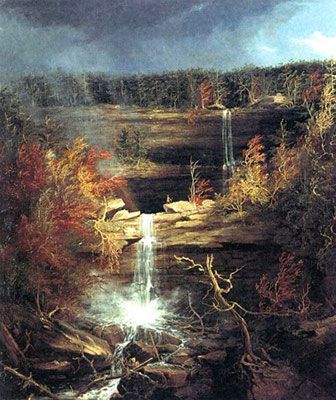
The Falls of Kaaterskill
Kaaterskill Falls cascades through the center of the painting, while shafts of sunlight illuminate a rocky ledge, framed by red and gold autumnal trees. A single figure, a Native American, stands on top of an outcrop, profiled against the dark caverns in the cliff behind him. The effect feels spontaneous and timeless, capturing the beauty of the scene as a natural resource. Yet, trouble looms. The painting is composed as an inverted triangle: its apex sits at the break of the falls with diagonals along the rising slopes on either side to lead the viewer to the higher falls in the upper right. Beyond this, a dense row of pines stretches along the horizon, along with an anvil-shaped thundercloud that creates a sense of impending doom.
Cole revisits a subject that had previously gained him fame with his Kaaterskill Upper Fall, Catskill Mountains (1825), painted after his first visit to the area. The region, known for its natural beauty, was viewed as a kind of natural Eden, yet, at the time of Cole's first visit, railings and a bridge had already been installed for the safety of the many tourists. In his depiction, however, Cole erased these manmade elements and included a Native American (even though the indigenous people had been driven from the area by this time) in an attempt to reverse time and preserve the original landscape for posterity.
Oil on canvas - The Warner Collection of American Fine and Decorative Arts, Gulf States Paper Corporation, Tuscaloosa, AL
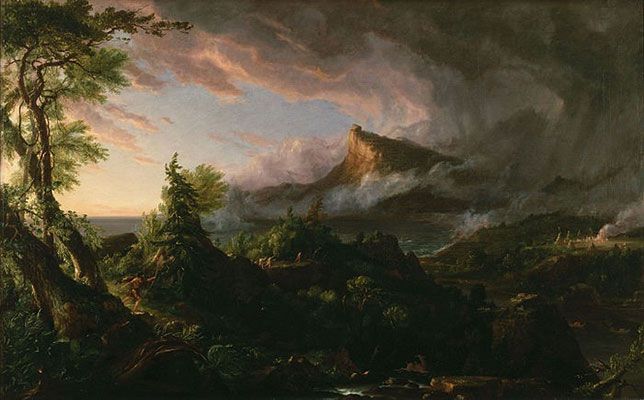
Course of Empire: The Savage State
With ambitions to transform landscape painting into a more important and celebrated genre, Cole centered his five-painting series, Course of Empire, on an allegorical cycle of historical progress. This, the first painting of the group, depicts an unspoiled wilderness at dawn. On this site, Cole depicts the rise and fall of civilization, a narrative foreshadowed by the looming storm that casts the dense forest into shadow. This gloom speaks to the demise of the unspoiled world, an ideal state represented by the hunter with bow and arrow who pursues a deer, along with an encampment of tipis and a billowing fire at the right, but it also points to the ultimate destruction of all of man's civilizing endeavors.
The Course of Empire cycle, painted between 1833 and 1836, was Cole's most ambitious project to date, moving from this first work to the The Arcadian or Pastoral State, The Consummation of Empire, Destruction, and the final painting, Desolation. The same landscape, featuring the crag in the background, is portrayed in each work to convey the contrast between enduring nature and human transience.
Despite Cole's interest in an independent American culture, the series is steeped in European influences. In its prioritizing of natural order and the smallness of man's impact on the world, Cole draws from German Romantics like Caspar David Friedrich. The structures of his grand empire are based on classical Roman architecture, popularized in 18th-century prints by artists such as Giovanni Battista Piranesi. Cole took his title from British bishop George Berkeley's "Verses on the Prospect of Planning Arts and Learning in America" (1726). He was also inspired by the Romantic poet Lord George Gordon Byron's Childe Harold's Pilgrimage (1812-1818), even quoting a verse in the promotions for the series:
There is the moral of all human tales;
'Tis but the same rehearsal of the past.
First freedom and then Glory - when that fails,
Wealth, vice, corruption - barbarism at last.
And History, with all her volumes vast,
Hath but one page...
With this series, Cole felt he had launched "a higher style of landscape," a historical and moralistic allegory. Indeed, Cole's reputation beyond a mere landscape painter was established: James Fenimore Cooper praised the series as not only "the work of the highest genius this country has ever produced," but "one of the noblest works of art that has ever been wrought." Although its display in New York was considered "the most successful exhibition of works of a single American artist, ever had in this city," Cole felt that his deeper message was overshadowed by praise for the pictorial qualities of the paintings. He would later simplify his symbolism for the Voyage of Life series to make it more easily understood by the general public.
Oil on canvas - New York Historical Society, New York New York
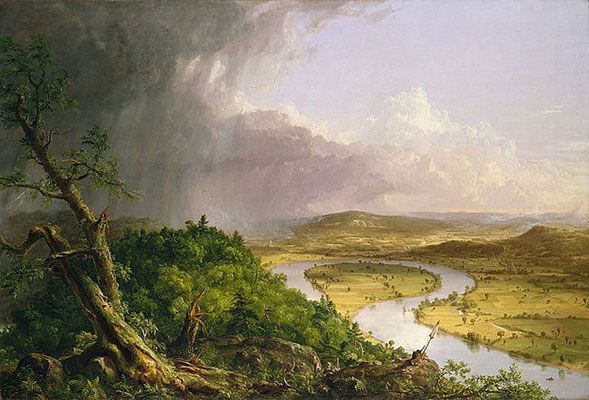
The Oxbow, View from Mount Holyoke, Northampton, Massachusetts, after a Thunderstorm
Considered a masterpiece of American landscape painting from its first showing at the National Academy of Design in 1836, Cole layered geographical fact with allegorical symbolism to create a deeply meaningful landscape. Selecting a distinctive site, a bend in the Connecticut River often called "The Oxbow," Cole places the viewer in a precise location (Mount Holyoke) while alluding to the cyclical qualities of nature. The conflict between wilderness and civilization, a dominant theme in Cole's work, is portrayed in the contrast between the dense, stormy wilderness at the left and the sunlit, cultivated plains on the right. The s two worlds are bridged only by the artist's vision, represented here by Cole's minuscule self-portrait. Showing himself at work, Cole declares the artist to be a visionary, in harmony with nature.
The painting was calculated to convey both civilized expansion and the untapped resources of the American continent. Although the wilderness is presented as a forest to be tamed, the brewing storm clouds and lightning-split trees remind the viewer of the ultimate power of nature. Both halves are intended to inspire awe; Cole both demonstrates the progress of man and his smallness before nature. As a viewer, we are carefully positioned within the dense forest, inviting us to partake in the sublime as experienced by the artist. Indeed, Cole traced this view from Basil Hall's Forty Etchings Made with the Camera Lucida in North America in 1827 and 1828; Hall had criticized Americans as indifferent to their native landscape, so Cole quoted his print in a depiction of the American landscape as "a union of the picturesque, the sublime, and the magnificent."
Oil on canvas - The Metropolitan Museum of Art, New York New York
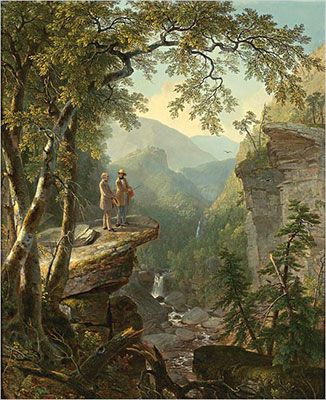
Kindred Spirits
Painted to commemorate the 1848 death of Thomas Cole, and his eulogy by William Cullen Bryant, this double portrait captures their likenesses and their shared dedication to the American landscape. Poised in conversation on a sunlit rocky outcrop overlooking a chasm carved by a stream, Durand creates a subtle sense of loss and nostalgia. This is particularly evident in the way the two waterfalls draw the viewer's eye toward the hazy, sunlit hills in the distance. Framed by overhanging branches and dense foliage, an atmospheric halo of light is created around the two men. They are dwarfed by their surroundings (no doubt the very attraction of this imagine location), suggesting that the fame of its human subjects is outweighed by their communion with the natural world.
Durand encountered the work of John Constable during a trip to England in the early 1840s; he was impressed, describing as having "more of simple truth and naturalness than any landscape I have ever before met with." As a result, Durand adopted a more naturalistic approach in his own work, seen here in his precise depiction of the different species of trees and the flowering foliage in the foreground. Constables influence can also be detected in the humble quiet of the scene and the naturalness with which Durant stages his figures. Emerging as the second leader of the Hudson River School, Durand gradually diverged from Cole's more allegorical approach to landscape in favor of more naturalistic effects.
Oil on canvas - Crystal Bridges Museum of American Art, Bentonville Arkansas
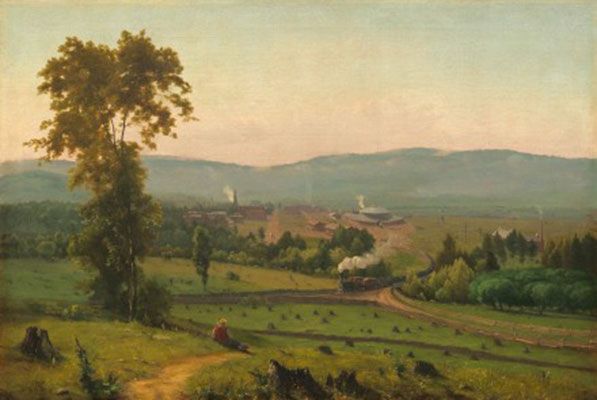
The Lackawanna Valley
This unusual landscape, which places industrialization at the heart of the composition, was commissioned to highlight an important new rail system near Scranton, Pennsylvania. This deliberate emphasis on the train differs from the more bucolic themes of Hudson River School painting, but uses many of the same techniques: the roundhouse is made larger to underscore the accomplishment of its construction, careful attention to accuracy creates a sense of immediacy, the harmonious relationship between man and nature is suggested in the intertwining contours and colors.
The painting is divided into thirds: a young man seated on a hill, a field of tree stumps, and the steam locomotives bustling in the distance. Despite its celebration of engineering and the sense of civilizing progress represented by the railroad, there remains a sense of ambiguity. Inness makes clear how the train system scars the landscape, emphasized by the swatch of cleared trees in the center of the canvas. The arrival of the railroad is linked with the destruction of the natural environment, capturing the contemporary tension between progress and preservation of America's wilderness. The young man represents a future where the view is not the pure beauty of nature but modern technology. How this modern vision is interpreted is left to the viewer.
Oil on canvas - The National Gallery of Art, Washington DC

Niagara
Painted on a grand scale, Church's majestic view of Niagara Falls is depicted on an unusually long canvas, chosen to create a panoramic effect. Furthering the viewer's sense of drama, he adopts an aerial perspective that reveals a greater view of the distance and of the cascading water. The viewer feels the exhilaration and awe of being poised above the brink of the falls.
Church visited the site on several occasions in 1856 to make preliminary oil and pencil sketches; the view he represents is a slight composite that suppresses the foreground in order to show a larger, sweeping vista that immerses the viewer in sublime nature. At the time, Niagara Falls was considered the greatest natural wonder of America, superior to any European site. It symbolized the nation's youth and vigorous promise. As a result, many artists in the 19th century had tried to depict the Falls; Church's work was the most successful, by far.
Unveiled as a single painting exhibition in New York, Church pioneered the idea of art as an event. Works like this were debuted as theatrical productions hung in a dark room and dramatically illuminated by gaslights. His theatrical presentation included binoculars and optical aids for better viewing, chromolithograph copies of the painting for purchase, and pamphlets that reprinted praise from the critics. These shows became popular attractions. More than 100,000 people visited this painting's show; the work then toured American cities, Great Britain, and was included in the 1867 Exposition Universelle in Paris. Its impressive scale and composition continue to influence contemporary artists, including the photographs of Lynn Davis such as Horseshoe Falls, Ontario Canada (1992) and the video artist Angie Keefer, who included a projection of the falls in her Fountain (2014).
Oil on canvas - The National Gallery of Art, Washington DC

Heart of the Andes
Defining the American landscape as broader than the United States, Church journeyed to Ecuador to sketch the dramatic terrain. Here, the landscape is depicted as a pastoral paradise. The waterfall breaks into a deep, reflective pool, drawing the viewer's eye to the center of the canvas, where it lingers over the richness of the surrounding vegetation. In the left, a distant, snow-capped, volcanic peak rises into the sky, becoming nearly indistinguishable from the clouds. In the middle ground, a prosperous hacienda glimmers at the edge of a lake, although even its luxuries are dwarfed by the surrounding bounties of nature.
Church employed large canvases to create a panoramic effect, which he amplified by including numerous small vignettes that encouraged the viewer to carefully observe the painting in sections. Botanical species and native birds are depicted with scientific detail, reflecting the artist's enthusiasm for the ideas of the scientist Alexander von Humboldt who argued that biology, botany, and geology combined to create the character of a place. At the same time, the painting is informed by Christian iconography: on the left an Ecuadorian peasant couple worship at a sunlit cross. Church positions the Americas as a new Eden.
Oil on canvas - The Metropolitan Museum of Art, New York New York

The Rocky Mountains, Lander's Peak
Using a ten-foot long canvas to create a monumental effect, Bierstadt transformed the landscape of the American west into a heroic, sublime scene. Although the painting depicts a camp of Native Americans and their horses in a meadow bordering a quiet pond, its primary focus is the towering mass of Lander's Peak and surrounding mountains. Filling the top of the canvas, the mountains are large and rugged in form, Bierstadt bathes them in an ethereal light, as if divine. Rather than looming ominously, the ridge suggests an expanse of space and the promise of benevolent, unspoiled terrain. The valley, with its stand of lush trees and gentle meadow, conveys a pastoral sense of harmonious nature, with the native people living in accord with the land.
In 1859, Bierstadt went on a government survey trip of the West, led by Frederick W. Lander, an army officer who would die during the Civil War. Bierstadt's advocacy, including this painting, led to the naming of this mountain after the fallen colonel. The subject of a heavily-promoted, single painting exhibition, accompanied by engravings and pamphlets, this work became the artist's most successful. Despite its documentarian roots, however, the painting is a composite. In order to convey the awe-inspiring vastness and possibility of the American West (particularly significant as an alternative to the North-South divisions of the war), Bierstadt depicts an ideal landscape rather than the actual view of Lander's Peak. As historian Anne F. Hyde explained, the work portrayed "the West as Americans hoped it would be."
Oil on canvas - The Metropolitan Museum of Art, New York New York
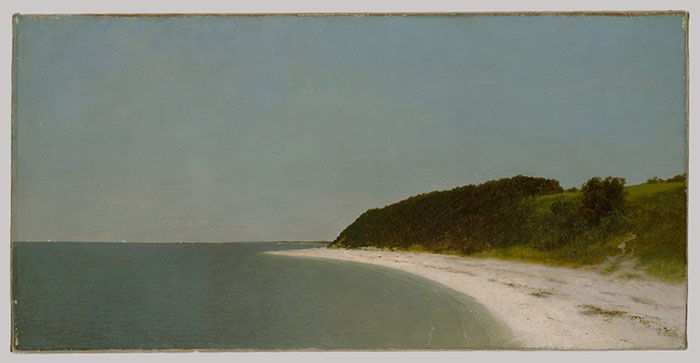
Eaton's Neck, Long Island
This landscape depicts an unremarkable stretch of coastline, with its white beach and green hills curving beneath a cloudless blue sky on Long Island. The work is remarkably simplified, almost modern in its elemental treatment of forms: the land is profiled against the sea and sky, with no distractions or embellishments. Kensett creates a contemplative sense of quiet and balance.
While traveling in Europe during the 1840s, Kensett had been impressed by the works of 17th century Dutch landscape artists; his later work (such as this) repeat their restrained palettes, cool colors, and rigorous composition of simple, familiar scenes. Painted in the summer before his death, this landscape depicts a scene that Kensett knew well, living on Contentment Island on Long Island Sound.
This work with its smooth finish, concealed brushstrokes, and contemplative quiet exemplifies the Luminist style. Unlike other second-generation Hudson River School artists like Bierstadt and Church who favored exotic landscapes, Kensett preferred smaller canvases of understated nature that he felt allowed an intimate encounter between the viewer and the landscape. This also reflects his interest in Transcendentalism, believing that the contemplation of nature helped connect the individual to intuitive, inner truths.
Oil on canvas - The Metropolitan Museum of Art, New York New York
Beginnings of The Hudson River School
The Hudson River School: The Group and Term
The Hudson River School was neither a school nor art movement in the contemporary sense of the term, but a group of landscape painters who began working in the Hudson River Valley of New York State. The name for the group has been variously attributed to either the art critic Clarence Cook or the artist Homer Dodge Martin, but, in any case, it was coined as a disparaging term in the 1870s to suggest that the group's style and subject matter were passé and provincial.
Early Leadership
The earliest works that could be categorized as Hudson River School paintings were by Thomas Doughty, one of the first American landscape artists, who painted quiet lyrical scenes of the region. The most famous and influential of the group, however, was Thomas Cole; it was under his leadership that the group became well-known and respected and thus, he is most often credited as the group's founder.
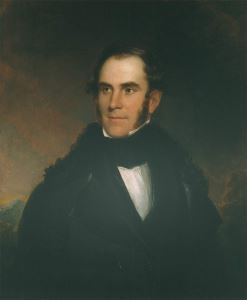
Cole was largely self-taught, only receiving some basic training as a painter and youthful experience as a wood engraver. When he began painting and sketching outdoors, taking an excursion to the Catskill Mountains in 1825, he had no academic training. Yet, when he displayed three landscape paintings (based on his outdoor sketches) at William Colman's bookshop and picture gallery in New York, they were discovered by John Trumbull, William Dunlap, and Asher B. Durand. (Trumbull purchased Kaaterskill Upper Fall, Catskill Mountains, Dunlap bought Lake with Dead Trees (Catskill), and Durand acquired View of Fort Putnam). The discovery of Cole's groundbreaking mix of realism and idealism was notable enough to be covered in the New York Evening Post. Trumbull (regarded as the painter of the American Revolution due to works like his Declaration of Independence (1819)), and Dunlap (a pioneer of American theatre and history) brought Cole's work to the attention of important patrons. Durand became close friends with Cole, and an early member of the Hudson River School himself. Other artists, including Martin Johnson Heade and Jasper Cropsey, soon followed in Cole's footsteps, hoping to repeat his success by painting the landscapes of the Adirondacks, the White Mountains, and the Catskills in upstate New York. Most of these artists worked outdoors to create preliminary oil and pencil sketches, then returned to their studios in New York City to complete the paintings. The resulting landscapes were often composites, creating an imagined and idealized landscape to achieve a stronger emotional effect.
Bread and Cheese Club and the Sketch Club
The Bread and Cheese Club, also called the Lunch Club, was an intellectual and artistic group created by the writer James Fenimore Cooper. Running from 1822 until 1827, its members included American writers, scholars, and professionals interested in the arts, such as Cole and Durand. With its regular meetings in New York City, the group was a gathering place for the latest ideas about American art and culture. When it disbanded, the Sketch Club, formed by Durand in 1827, carried on the tradition.
A number of influential connections formed within this circle. Cooper was one point of focus; as one of the most famous American novelists, many artists illustrated or painted scenes taken from his works. In particular, Cooper considered Cole "one of the very first geniuses of the age," and Cole was deeply influenced by Cooper's writing. Cole would eventually paint four scenes from Cooper's The Last of the Mohicans (1826).
Other connections promoted more classicizing and idealizing influences on the Hudson River School artists. William Cullen Bryant, best known for his poem, "Thanatopsis," had close personal and professional relationships with Durand and Cole. Indeed, Durand's Kindred Spirits (1849) depicts Bryant and Cole as paired explorers. When Durand helped found the National Academy of the Arts of Design in 1836, Bryant was elected as its "Professor of Mythology and Antiquities." Durand paid homage to Bryant in his Scene from Thanatopsis (1850), taking to heart the poem's exhortation: "Go forth under the open sky and list/ to nature's teachings."
These associations shaped and developed American art and artistic institutions, especially when Church and Durand helped established the Metropolitan Museum of Art in New York during the 1850s; the museum became the example for other collections throughout the country.
The Knickerbocker School and Magazine
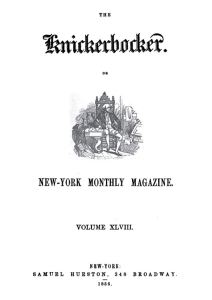
Another forum for these nationalistic interdisciplinary connections between artists and writers was the Knickerbocker Group. Named for Washington Irving's Knickerbocker's History of New York (1809), the group included James Fenimore Cooper, Henry Wadsworth Longfellow, Oliver Wendell Holmes, James Russell Lowell, J.K. Paulding, and William Cullen Bryant along with Irving himself. They hoped to establish a truly American culture, separate from European influence, with New York City as its center. (Knickerbocker was the name of Irving's fictional character; indeed, he has become a lasting part of the city's culture, reflected in the naming of the New York Knicks)
Many of the group's members contributed to the Knickerbocker Magazine (also called New-York Monthly Magazine), which was published from 1833 to 1865, circulating literary works along with essays and editorials on the fine arts. Often its contributions focused on America's "vanishing wilderness," an early environmental theme that emphasized the American national landscape. This interest created a natural affinity between its writers and the painters of the Hudson River School; they also shared the desire to create a uniquely American art and literature. Crossovers include Cole's first acclaimed masterwork Gelyna (View near Fort Ticonderoga) (1826), which was based on Gulian Verplanck's short story of the same title.
Romanticism
Largely influenced by European Romanticism, the Hudson River School intended to convey nature's sublime beauty. Cole's influential "Essay on American Scenery" emphasized the emotive possibilities for landscape painting, writing, "American Scenery is a subject that to every American ought to be of surpassing interest...it is his own land; its beauty, its magnificence, its sublimity - all are his; and how undeserving of such a birthright if he can turn towards it an unobserving eye, an unaffected heart!" To best convey the magnificence of the American landscapes, they favored views of rugged and remote wilderness or of idyllic and lyrical countryside. If man's presence was noted, it was most often favorably depicted as progress and yet dwarfed by the scale of raw nature.
The concept of the sublime is central to Romanticism, considered an ideal by its practitioners. Rejecting the more cerebral narratives of the Neo-Classical style, they calculated their compositions, palettes, and subjects to evoke strong emotions in the viewer. Although this emotional response could be geared towards fear or repulsion, landscape artists most commonly aspired to awe and wonder at the beauty of nature and humility before its power. The sublime was achieved in this direct appeal to the senses through representations of the extraordinary.
Unlike French Romanticism that was often connected to revolutionary impulses in society, Romanticism in the Hudson River School was more closely tied to contemporary German and British examples of symbolic and meaningful landscape painting. At the same time, however, the style was intrinsically nationalistic, connected to a rising sense of American identity by conveying the unique beauty of the native landscape. While painters could not rival the history of their European counterparts, their large paintings of expansive, untamed lands spoke of American potential and promise.
The Second Generation and Focus on Naturalism
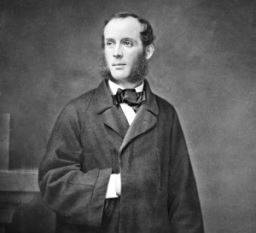
When Cole died in 1848, leadership of the Hudson River School fell to Asher B. Durand. Influenced by the landscapes of the British Romantic painter, John Constable's landscapes, Durand shifted the group's style towards more naturalistic painting. As head of the National Academy of Design, he stressed careful observation and representation. He encouraged scenes of quiet communion with nature rather than dramatic allegory.
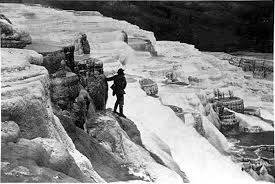
The second generation of Hudson River School painters centered around Durand, Albert Bierstadt, John Frederick Kensett, Sanford Robinson Gifford, along with Cole's only student, Frederic Edwin Church. Although they drew heavily from Cole's example, Church and Bierstadt began to explore other geographical areas, particularly in Church's landscapes of South America and Bierstadt's visits to paint the American West. Both regions were considered epic spaces of untapped potential and sublime wilderness and their work connected with American expansion and the concept of Manifest Destiny. The resulting large-scale landscapes were often composite or idealized scenes, calculated to create panoramic effects. Showmanship dominated the public display of these works, as dramatically staged, single picture exhibitions were enormously popular events. Church and Bierstadt became celebrities. Church continued to explore more exotic locations, eventually painting in the Middle East and the Arctic, as shown in his The Icebergs (1861) (which was directly influenced by the work of the Romantic German landscape painter, Caspar David Friedrich).
Other second generation artists, like John Frederick Kensett, developed new themes that would be labeled Luminism, emphasizing the effects of light in contemplative scenes of seascapes or other bodies of water. These artists created small intimate canvases that focused on familiar areas, a contrast with the dramatic sublime of their colleagues. The Luminists usually returned to the same areas again and again to study the shifts in light and atmosphere.
The Hudson River School: Concepts, Styles, and Trends
Allegorical Painting
Following the early successes of his landscape paintings, Cole aimed to emulate history painters by layering his compositions with symbolic meaning. His The Course of Empire (1833-1836), five paintings depicting the rise and fall of a civilization, exemplifies this turn to allegorical or metaphorical painting. Indeed, a number of Hudson River School painters developed an allegorical theme in their works in order to convey more complex messages. Albert Bierstadt's Last of the Buffalo (1888) is both an accurate depiction of the topographical features of the Great Plains and an imagined buffalo hunt, designed as an allegory of the destruction of the natural world and a vanishing way of life.
Rocky Mountain School
In the 1860s, Bierstadt and Thomas Moran turned their attention to the American West, earning them (along with Thomas Hill and William Keith) the title of the Rocky Mountain School. They were not just interested in depicting the Western landscape, but viewed it as symbolizing the vast sense of promise of a nation that was expanding westward. Many of their paintings were composites, drawing together a selection of ideal views, in order to convey the uniqueness of the Rocky Mountains, the Yellowstone area, and the Yosemite Valley to an East coast audience. Artists often accompanied scientific expeditions, like Bierstadt's 1859 expedition to the Rocky Mountains in Wyoming or Moran's 1871 United States Geological Survey of Yellowstone. As a result, their artwork was integrally connected to a sense of national discovery. It also influenced the preservation of these areas: the enormous popularity of Moran's The Grand Canyon of the Yellowstone (1872) gave impetus to the movement to create Yellowstone National Park.
Luminism
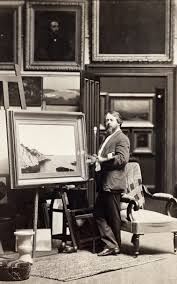
Focusing on the effects of light, Luminist painters most often depicted water scenes from an aerial perspective, emphasizing a finished reflective surface without visible brushstrokes. The artists were influenced by the Transcendentalist philosophy that contemplation of nature led to spiritual truth. Like Impressionism, Luminism emphasized the effects of light but differed in its attention to precise detail, its total concealment of brushstrokes, and its quiet, contemplative view of nature; although they are contemporary, the two movements were not connected. Indeed, the artists who adopted this style did not refer to themselves as Luminists; the term originated in the 1950s.
Later Developments - After The Hudson River School
In the 1870s, the Hudson River School fell out of fashion, as the influence of the Barbizon School and Impressionism dominated the art world. In comparison, Hudson River School realism and mimesis seemed out of date, sometimes sentimental, or of merely historical interest. Yet, while artistically unfashionable, the school had a profound cultural influence, popularizing its wilderness ideal, which encouraged preservation efforts and the development of national parks. Olana, Church's expansive estate overlooking the Hudson River, has been preserved as a historic landmark. Home to a museum today, visitors can tour Church's home and the grounds and view installations of historical and contemporary art inspired by the Hudson River School. Thomas Cole's home in the Catskills has also been maintained as a museum.
Regionalism or American Scene Painting, drew upon the model of the Hudson River School as it developed in the American Midwest during the 1930s. Artists like Thomas Hart Benton, Grant Wood, and John Steuart Curry sought to create a modern but distinctly American art. They adopted the rural landscapes, realistic detail, and regional identity that had characterized the earlier movement.
In its depictions of wilderness and sublime views, modern photography was also influenced by the Hudson River School, particularly as seen in works like Ansel Adam's The Tetons and the Snake River (1942).
In the postwar years, Hudson River School painting was both critiqued and emulated. In the 1960s, a new generation of photographers like Ed Ruscha and Robert Adams deliberately posited their photographs of banal suburban modernity as a challenge to dramatic and heroic visions of nature. However, with the development of Land art and environmental activism in the 1970s, the style came back into vogue. Its influence continues today: the exhibition "River Crossings: Contemporary Art Comes Home" (2015) highlighted the work of contemporary artists whose work is directly or implicitly associated with The Hudson River School by installing works like Angie Keefer's Fountain (2014) in Cole's historic home. Mixing nature and industry, Fountain projects an image of Niagara Falls adjusting the water's according to computer data from the Commodities Futures Indexes. The exhibition also highlighted work by Kiki Smith, Jerry Gretzinger, Maya Lin, Lynn David, Valerie Hegarty, and Charles LeDray. Valerie Hegarty's Fallen Bierstadt (2007) reinterprets Bierstadt's landscapes and ideals of Manifest Destiny into depictions that decay like the fallen canvas.
The New Hudson River School, a group of approximately twenty-five artists, extend the core identity of the 19th-century movement by painting contemporary landscapes and subjects from the Hudson River Valley and the surrounding area. The Thomas Cole National Historic Site is an important site for these connections, particularly with its series, Open House: Contemporary Art in Conversation with Cole, that explores intersections of contemporary art with Cole's art. In 2016, Jason Middlebrook's installation, Nature Builds / We Cover (2016) installed paintings made on hardwood planks inside Cole's home.
Useful Resources on The Hudson River School
-
![A "Grand Tour" of the Hudson River School at the New-York Historical Society]() 39k viewsA "Grand Tour" of the Hudson River School at the New-York Historical Society
39k viewsA "Grand Tour" of the Hudson River School at the New-York Historical Society -
![The Hudson River School: Artistic Pioneers]() The Hudson River School: Artistic PioneersOur PickBy PBS
The Hudson River School: Artistic PioneersOur PickBy PBS
-
![Thomas Cole's Warning to America - The Course of Empire]() 27k viewsThomas Cole's Warning to America - The Course of Empire
27k viewsThomas Cole's Warning to America - The Course of Empire -
![Thomas Cole: The Voyage of Life (1842)]() 22k viewsThomas Cole: The Voyage of Life (1842)By the National Gallery of Art
22k viewsThomas Cole: The Voyage of Life (1842)By the National Gallery of Art -
![Albert Bierstadt and the American Land]() 8k viewsAlbert Bierstadt and the American LandOur PickBoston Museum of Fine Arts
8k viewsAlbert Bierstadt and the American LandOur PickBoston Museum of Fine Arts -
![Frederic Edwin Church: Heart of the Andes]() 4k viewsFrederic Edwin Church: Heart of the AndesOur PickBy KUMediaProductions
4k viewsFrederic Edwin Church: Heart of the AndesOur PickBy KUMediaProductions -
![Asher B. Durand's "Kindred Spirits" and Picturing the Americas]() 1k viewsAsher B. Durand's "Kindred Spirits" and Picturing the Americas
1k viewsAsher B. Durand's "Kindred Spirits" and Picturing the Americas
-
![Hudson River School of American Landscape Painting with David Dearinger]() 14k viewsHudson River School of American Landscape Painting with David DearingerBy WGBHForum / March 20, 2014
14k viewsHudson River School of American Landscape Painting with David DearingerBy WGBHForum / March 20, 2014 -
![Artists on Artists Lecture Series - Matthew Coolidge on the Hudson River School]() 395 viewsArtists on Artists Lecture Series - Matthew Coolidge on the Hudson River SchoolOur PickBy Dia Art Foundation / October 29, 2007
395 viewsArtists on Artists Lecture Series - Matthew Coolidge on the Hudson River SchoolOur PickBy Dia Art Foundation / October 29, 2007 -
![Angela Miller on "Nature's History: American Landscape Art and Environmental Thinking"]() 1k viewsAngela Miller on "Nature's History: American Landscape Art and Environmental Thinking"Our PickBy Mildred Lane Kemper Art Museum / November 15, 2013
1k viewsAngela Miller on "Nature's History: American Landscape Art and Environmental Thinking"Our PickBy Mildred Lane Kemper Art Museum / November 15, 2013
 Ask The Art Story AI
Ask The Art Story AI